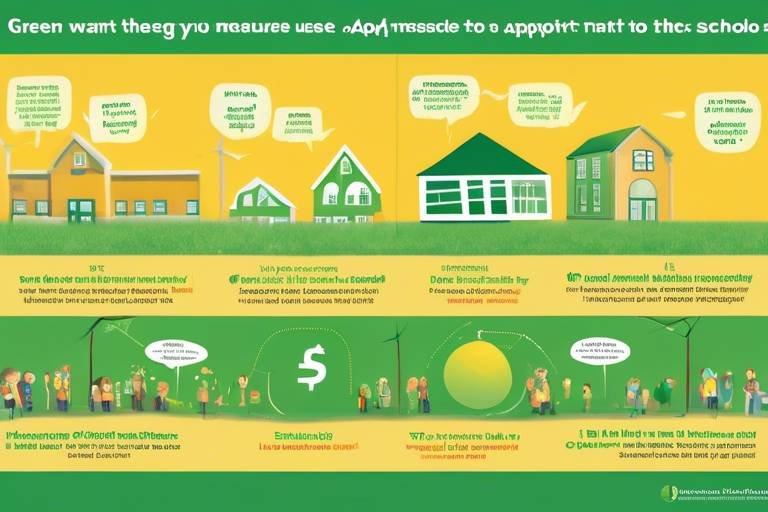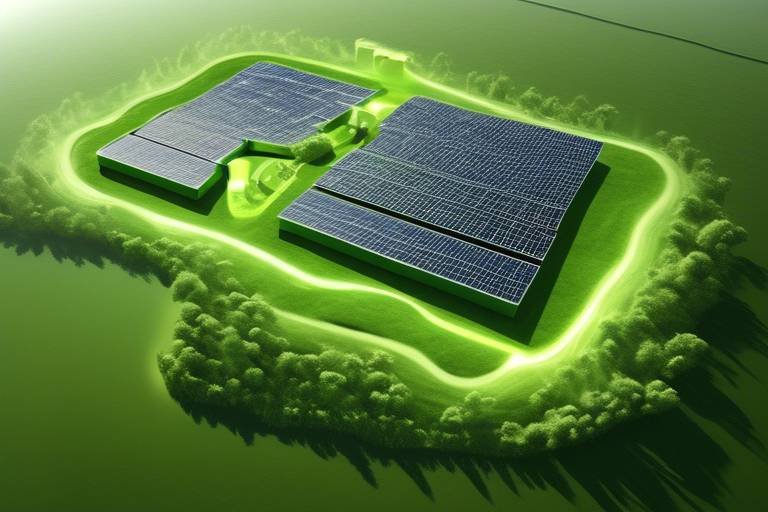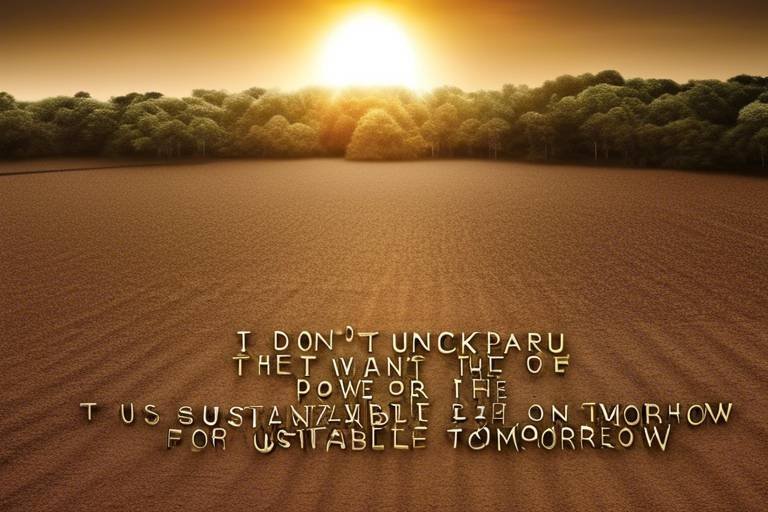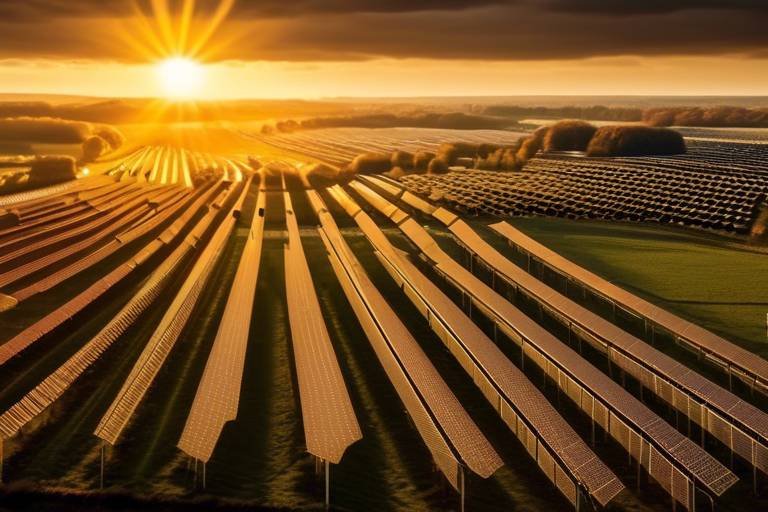How Science Fiction is Inspiring Green Energy Innovations
Imagine a world where our energy needs are met not by fossil fuels, but by the very stars above us. Science fiction has long been a playground for the imagination, allowing writers to explore futuristic concepts that challenge our current understanding of technology. This genre not only entertains but also serves as a powerful catalyst for innovation, particularly in the realm of green energy. By presenting bold ideas and alternative realities, science fiction encourages scientists and engineers to think outside the box, pushing the boundaries of what is possible in sustainable energy solutions.
From the pages of classic novels to the screens of modern films, the themes of renewable energy and environmental sustainability resonate deeply. These narratives often depict worlds grappling with the consequences of energy mismanagement, serving as a stark reminder of the challenges we face today. They spark curiosity and inspire real-world innovations that may one day turn these fictional concepts into reality. So, how exactly does science fiction inspire advancements in green energy? Let's dive into the fascinating intersection of creativity and technology.
Science fiction serves as a lens through which we can explore the future of energy. By presenting futuristic concepts, it challenges current technologies and encourages researchers to explore new possibilities. For instance, the idea of harnessing energy from the sun through advanced solar panels or tapping into the power of wind through innovative turbine designs often finds its roots in speculative narratives. These stories push scientists to think creatively about how we can utilize our natural resources more effectively and sustainably.
Many science fiction works envision alternative energy sources that seem like pure fantasy today, such as fusion power and antimatter. Yet, these imaginative concepts often inspire real-world researchers to pursue groundbreaking advancements in renewable energy technologies. The allure of harnessing the power of the universe is not just a dream; it propels scientists to investigate new avenues for energy production that could one day revolutionize our approach to sustainability.
In numerous science fiction stories, solar energy is depicted as a primary energy source. This portrayal pushes the boundaries of current solar technology and motivates researchers to enhance efficiency and accessibility. For example, the concept of solar roadways—roads embedded with solar panels—has gained traction from its depiction in fiction, leading to real-world projects aimed at integrating solar energy into infrastructure. Imagine driving on a highway that generates clean energy while you travel!
The idea of solar roadways isn't just a whimsical thought; it's a vision that many engineers and innovators are working to bring to life. By embedding solar panels into the very roads we drive on, we can create a sustainable energy source that powers streetlights, electric vehicles, and even homes. This innovative approach to energy generation is a testament to how science fiction can inspire real-world solutions.
Science fiction frequently explores the idea of harnessing solar power from space, inspiring ongoing research into satellite technology that could capture and transmit solar energy back to Earth. This concept, while ambitious, is being taken seriously by scientists and engineers who see the potential for a virtually limitless energy source that could help alleviate our dependence on fossil fuels.
Wind energy is another area where science fiction has made a significant impact. Speculative narratives often highlight the importance of wind as a clean energy source, driving innovation in turbine design and placement. These stories encourage researchers to maximize efficiency and reduce environmental impact, ultimately leading to more sustainable practices in real-world applications.
One of the most compelling aspects of science fiction is its ability to highlight environmental challenges while presenting imaginative solutions. Many stories depict dystopian futures caused by climate change, prompting discussions around the urgent need for technological responses and sustainable practices. This narrative framework encourages scientists to address real-world issues, such as climate change and resource depletion, through innovative green technologies.
As we navigate the complexities of climate change, science fiction serves as a mirror reflecting our potential futures. By showcasing the consequences of inaction, these stories foster a sense of urgency and inspire technological advancements that can help avert similar outcomes. The narratives compel us to consider how we can innovate to create a more sustainable world.
Fictional narratives often explore themes of resource scarcity and sustainable living, inspiring new approaches to resource management and conservation in green energy practices. These stories remind us that our resources are finite and that we must be responsible stewards of the planet. They encourage us to think critically about how we can make the most of what we have while preserving it for future generations.
Science fiction shapes public perception of green energy technologies, influencing societal attitudes and fostering a culture of innovation. As people engage with these narratives, they become more open to embracing sustainable practices for a better future. The imaginative worlds presented in science fiction can shift perceptions, making green energy technologies more relatable and desirable.
By captivating young minds, science fiction encourages the next generation to pursue careers in science and engineering. This engagement is crucial for driving advancements in green energy technologies and sustainable practices. When children see heroes harnessing renewable energy in their favorite stories, they are inspired to become the innovators of tomorrow.
The intersection of science fiction and green energy fosters collaboration between artists, scientists, and engineers. This multidisciplinary approach is vital for solving complex environmental challenges. By working together, these diverse groups can create innovative solutions that might not emerge within the confines of a single discipline.
- How does science fiction influence real-world technology?
Science fiction inspires innovation by presenting futuristic concepts that challenge our current understanding of technology, encouraging researchers to explore new possibilities. - What are some examples of green energy concepts from science fiction?
Examples include solar roadways, space-based solar power, and advanced wind turbine designs. - How can science fiction engage young people in STEM fields?
By captivating young minds with imaginative stories, science fiction encourages interest in science, technology, engineering, and mathematics (STEM) careers.

The Role of Science Fiction in Shaping Ideas
This article explores the fascinating intersection of science fiction and green energy, highlighting how imaginative narratives can drive technological advancements and inspire innovative solutions for a sustainable future.
Science fiction serves as a catalyst for innovation by presenting futuristic concepts that challenge current technologies. When we dive into the pages of a sci-fi novel or watch an imaginative film, we are often confronted with ideas that seem outlandish or even impossible. Yet, these very ideas spark curiosity and creativity among scientists and engineers, pushing them to explore new possibilities in green energy solutions. For instance, the depiction of advanced technologies in these narratives often encourages real-world researchers to think outside the box, leading to breakthroughs that might not have been considered otherwise.
Consider how many of our modern inventions were once just dreams found in science fiction. From the early days of Jules Verne's Twenty Thousand Leagues Under the Sea to the more recent Star Trek series, these stories have inspired generations to pursue careers in science and technology. The imaginative landscapes of science fiction can ignite a spark of inspiration, leading to tangible innovations that address the pressing issues of our time, especially in the realm of green energy.
Moreover, science fiction often presents a world where humanity must adapt to new energy sources due to environmental crises. This narrative device not only entertains but also serves as a warning, urging us to consider the consequences of our current energy practices. By showcasing both the potential and the pitfalls of various technologies, science fiction encourages a dialogue about sustainability and the future of our planet.
In fact, many contemporary scientists cite science fiction as a significant influence on their work. It fosters an environment where imagination meets reality, allowing for the exploration of concepts like renewable energy and sustainable practices. This intersection is crucial because, as we face challenges such as climate change, resource depletion, and energy crises, the insights gained from speculative narratives can guide research and development in green technologies.
To illustrate this point, let’s take a look at a few examples of how science fiction has inspired real-world innovations:
| Science Fiction Work | Innovative Concept | Real-World Application |
|---|---|---|
| Star Trek | Replicators | 3D printing and sustainable manufacturing |
| The Matrix | Virtual Reality | Training simulations for renewable energy technologies |
| Wall-E | Waste Management Drones | Automated recycling and waste sorting technologies |
As we can see, the influence of science fiction is profound. It not only inspires new technologies but also encourages a broader understanding of the potential consequences of our energy choices. By imagining a future where sustainability is paramount, science fiction invites us to take action in our present.
In conclusion, the role of science fiction in shaping ideas is invaluable. It opens the door to new possibilities, encourages interdisciplinary collaboration, and inspires the next generation of innovators to tackle the challenges of green energy. As we continue to explore this fascinating intersection, we can only hope that the imaginative narratives of today will lead to the sustainable technologies of tomorrow.
- How does science fiction influence technological advancements?
Science fiction often presents futuristic ideas that inspire scientists and engineers to explore innovative solutions, pushing the boundaries of current technology. - Can you give examples of real-world technologies inspired by science fiction?
Yes! Technologies like 3D printing, virtual reality, and automated waste management have roots in sci-fi concepts. - Why is sustainability a common theme in science fiction?
Many sci-fi narratives address the consequences of environmental neglect, prompting discussions about sustainability and the need for green technologies.

Futuristic Energy Sources in Sci-Fi
Science fiction has long been a playground for the imagination, allowing writers and creators to explore futuristic energy sources that challenge our understanding of physics and technology. These narratives often present innovative concepts, such as fusion power and antimatter energy, that not only entertain but also inspire real-world scientists and engineers to push the boundaries of renewable energy technologies. By envisioning a future where energy is abundant and clean, science fiction serves as a beacon of hope and a call to action for those seeking sustainable solutions.
Take, for example, the concept of fusion power. Often depicted in sci-fi as the ultimate energy source, fusion promises to provide a nearly limitless supply of energy by fusing atomic nuclei, much like the processes that power our sun. This idea, while still in the experimental stages in reality, has spurred significant research into nuclear fusion technology, with projects like ITER aiming to make fusion a viable energy source. The allure of harnessing the power of stars has captivated imaginations and motivated scientists to develop safer and more efficient energy systems.
Similarly, the notion of antimatter—the mysterious counterpart to matter—has found its way into numerous sci-fi tales. The potential for antimatter propulsion systems not only excites the imagination but also encourages physicists to explore its practical applications. Although the production of antimatter is currently incredibly costly and inefficient, the very idea of using it as a clean energy source has inspired ongoing research, pushing the boundaries of what we believe is possible.
In addition to these high-energy concepts, science fiction often highlights more accessible technologies, such as solar power. Many stories imagine a future where solar energy is the primary energy source, leading to advancements in solar panel efficiency and integration into everyday life. This narrative not only reflects current trends in renewable energy but also propels researchers to innovate and enhance solar technologies. For instance, the idea of solar roadways, which was popularized in various sci-fi works, has led to real-world initiatives aimed at creating roads embedded with solar panels, generating energy while serving their primary purpose.
Furthermore, the concept of space-based solar power is another fascinating area explored in science fiction. The idea of capturing solar energy in space and transmitting it back to Earth could revolutionize the way we think about energy consumption. As we continue to explore the cosmos, ongoing research into satellite technology and energy transmission aims to make this vision a reality, inspired by the imaginative worlds of science fiction.
In summary, the futuristic energy sources presented in science fiction not only spark our imagination but also serve as a crucial source of inspiration for scientists and engineers. By challenging the status quo and envisioning a world powered by clean, renewable energy, these narratives encourage innovation and drive the pursuit of groundbreaking advancements in green energy technologies.
- What is fusion power? Fusion power is the process of combining atomic nuclei to release energy, similar to the reactions that occur in the sun. It has the potential to provide a nearly limitless and clean energy source.
- How does antimatter work as an energy source? Antimatter is the opposite of normal matter; when they come into contact, they annihilate each other, releasing vast amounts of energy. While it's currently expensive to produce, its theoretical applications are fascinating.
- What are solar roadways? Solar roadways are roads embedded with solar panels that generate electricity while serving as a transportation surface. This concept has gained attention from both sci-fi and real-world projects.
- Can we harness solar power from space? Yes, the concept of space-based solar power involves capturing solar energy in space and transmitting it back to Earth, which could revolutionize energy consumption.

Solar Power in Speculative Narratives
When we think of solar power in the realm of science fiction, our minds often drift to vivid depictions of futuristic cities bathed in sunlight, where energy is as abundant as the air we breathe. This imaginative portrayal serves not just as entertainment but also as a powerful motivator for real-world advancements in solar technology. In many speculative narratives, solar energy is not merely a backdrop; it becomes a central theme that drives the plot and the technological innovations within it.
For instance, consider the classic sci-fi tales where solar panels are integrated into every aspect of life. From solar-powered vehicles that zip through bustling metropolises to entire buildings designed to capture and utilize solar energy efficiently, these narratives challenge our current understanding of what’s possible. They push the boundaries of innovation, inspiring engineers and scientists to explore new materials and designs that could lead to more efficient solar panels. In essence, these stories act as a catalyst for change, igniting the imaginations of those who might one day turn these fictional technologies into reality.
Moreover, the depiction of solar power in speculative narratives often emphasizes not just the technology itself but also its potential to transform society. Imagine a world where energy scarcity is a thing of the past, where communities thrive on renewable energy sources, and where environmental sustainability is not just a goal but a way of life. This vision is not far-fetched; it’s a reflection of what many researchers are striving to achieve today. The stories we consume can shape our understanding and acceptance of these technologies, making them more relatable and desirable to the general public.
In addition to inspiring technological advancements, these narratives also highlight the importance of accessibility and inclusivity in energy solutions. Many science fiction works illustrate how solar power can be harnessed in diverse environments, from urban settings to remote areas, showcasing its versatility and potential for global impact. This is particularly relevant in our current climate crisis, where the need for sustainable energy solutions is more urgent than ever.
As we delve deeper into the realm of solar power in speculative narratives, we can see a common thread: the quest for a sustainable future. These stories often serve as a mirror, reflecting our hopes and fears about the environment and our reliance on fossil fuels. They challenge us to think critically about our energy consumption and inspire us to seek out innovative solutions that can lead to a cleaner, greener planet.
In conclusion, the portrayal of solar power in science fiction is not merely a fanciful escape into the unknown. It is a powerful tool for inspiration that can lead to tangible advancements in green energy technologies. As we continue to explore these narratives, we should remain open to the possibilities they present and the innovations they inspire.
- How does science fiction influence real-world energy technologies?
Science fiction often presents imaginative concepts that challenge current technologies, encouraging researchers to explore new possibilities and innovate in fields like renewable energy. - What are some examples of solar power in science fiction?
Many stories depict advanced solar technologies, such as solar roadways, solar-powered vehicles, and space-based solar power systems, inspiring real-world research and development. - Can science fiction help combat climate change?
Yes, by raising awareness and inspiring innovative solutions, science fiction can motivate individuals and organizations to adopt sustainable practices and technologies. - How can I get involved in green energy initiatives?
Consider pursuing education in science and engineering, volunteering for environmental organizations, or advocating for sustainable practices in your community.

Solar Roadways: A Vision from Fiction
Imagine a world where every road, parking lot, and pathway is not just a means of transportation but also a source of renewable energy. This visionary concept, often depicted in science fiction, is starting to become a reality with the development of solar roadways. These innovative surfaces are designed to capture solar energy while providing a durable and functional roadway. The idea is not just a dream; it's an inspiration drawn from the pages of speculative narratives that challenge our traditional views on energy and infrastructure.
In many science fiction stories, solar roadways are portrayed as an integral part of a sustainable future, where urban landscapes are transformed into energy-producing environments. The beauty of this concept lies in its dual functionality. Not only do these roads serve their primary purpose of facilitating travel, but they also harness the sun's energy, contributing to the grid and reducing our dependence on fossil fuels. This idea has sparked real-world projects aimed at integrating solar technology into our existing infrastructure.
For instance, one of the most notable projects is the Solar Roadways initiative, which aims to create a modular paving system made of durable solar panels. These panels can withstand the weight of vehicles while generating electricity that can power streetlights, signage, and even homes nearby. The potential benefits are enormous:
- Energy Generation: Solar roadways can produce substantial amounts of renewable energy.
- Reduced Carbon Footprint: By utilizing solar energy, we can significantly cut down on greenhouse gas emissions.
- Enhanced Safety: Some designs include features like LED lights embedded in the panels for better visibility and traffic management.
Moreover, the concept of solar roadways aligns perfectly with the need for sustainable urban development. As cities continue to grow, finding innovative ways to integrate renewable energy into everyday infrastructure is crucial. The idea of transforming roads into energy-generating surfaces not only addresses energy needs but also promotes a greener lifestyle.
However, the journey from fiction to reality is fraught with challenges. The technology must be economically viable and robust enough to handle the wear and tear of daily traffic. Additionally, public acceptance and regulatory hurdles pose significant obstacles. Yet, the vision remains strong, driven by the belief that if we can dream it, we can achieve it. Science fiction has a unique way of pushing the boundaries of our imagination, and solar roadways are a perfect example of how these narratives can inspire tangible innovations in green energy.

Space-Based Solar Power Concepts
The idea of harnessing solar energy from space is not just a flight of fancy; it’s a concept that has been explored in various science fiction narratives and is gradually becoming a focal point for real-world research. Imagine a scenario where satellites orbiting the Earth capture the sun's rays, convert them into energy, and then beam that energy back down to our planet. Sounds like something out of a sci-fi movie, right? Yet, this vision is increasingly being taken seriously by scientists and engineers alike.
One of the most compelling aspects of space-based solar power (SBSP) is its potential to provide a consistent and abundant energy source. Unlike terrestrial solar panels, which are subject to weather conditions and day-night cycles, solar panels in space could theoretically collect solar energy 24/7, providing a steady stream of power. This leads us to consider how SBSP could revolutionize our energy landscape. Imagine a world where energy shortages are a thing of the past, and we can power entire cities with clean energy beamed down from the heavens!
However, the technical challenges are significant. To make SBSP a reality, we need to develop advanced technologies to efficiently convert solar energy into microwave or laser energy, transmit it back to Earth, and then convert it again into usable electricity. This requires not just innovative engineering but also substantial investment and international collaboration. Governments and private sectors are beginning to recognize this potential, with various projects and initiatives being launched worldwide.
To give you a clearer picture of the current state of SBSP, consider the following table that outlines key projects and their objectives:
| Project Name | Location | Objective |
|---|---|---|
| Space Solar Power Initiative | United States | Develop a prototype for energy transmission from space |
| Japanese Space Solar Power System | Japan | Launch a satellite to test energy collection and transmission |
| European Space Agency SBSP Program | Europe | Research feasibility and potential applications of SBSP |
While the technical hurdles are daunting, the potential benefits of SBSP are equally impressive. It could not only help mitigate the effects of climate change by providing a clean energy source but also enhance energy security by diversifying our energy supply. Furthermore, as we explore the cosmos, SBSP could play a crucial role in supporting future lunar and Martian colonies, providing them with the energy needed to thrive in harsh environments.
In conclusion, the concept of space-based solar power is a thrilling intersection of science fiction and cutting-edge technology. It challenges our imagination while simultaneously pushing the boundaries of what is possible in renewable energy. As we continue to explore this frontier, who knows what other innovations might emerge? The sky is not the limit; it’s just the beginning!
- What is Space-Based Solar Power?
Space-Based Solar Power refers to the concept of collecting solar energy in space and transmitting it back to Earth for use as electricity. - How does it work?
Solar panels in space capture sunlight, convert it into energy, and then transmit it back to Earth using microwaves or lasers. - What are the benefits of SBSP?
SBSP can provide a constant energy supply, reduce reliance on fossil fuels, and support future space exploration efforts. - What challenges does SBSP face?
Technical challenges include energy conversion efficiency, transmission methods, and the high costs of launching and maintaining satellites.

Wind Energy Innovations in Fiction
Wind energy has long been a staple in science fiction narratives, often portrayed as a clean and abundant resource that holds the key to a sustainable future. These imaginative tales not only entertain but also inspire real-world innovations in turbine design and energy efficiency. In many sci-fi stories, we see wind energy harnessed in ways that push the boundaries of current technology, encouraging engineers and scientists to think outside the box. For instance, the depiction of enormous, floating wind farms in the sky could lead to advancements in airborne wind energy systems, which capture stronger winds at higher altitudes.
Moreover, these fictional representations often highlight the importance of strategic placement and design of wind turbines. In a world where climate change is a pressing concern, the narratives emphasize the need for turbines that are not only efficient but also environmentally friendly. This has sparked real-life discussions about how to minimize the impact of wind farms on local ecosystems while maximizing energy output. A key takeaway from these stories is the potential for integrating wind energy solutions into urban landscapes, making them part of the everyday environment rather than isolated installations.
For example, consider the concept of vertical-axis wind turbines that are often featured in speculative fiction. Unlike traditional turbines, these designs can capture wind from any direction, making them ideal for urban settings where wind patterns can be unpredictable. This innovation is not just a figment of imagination; it is being explored in real-world applications as cities look to diversify their energy sources and reduce their carbon footprint.
In addition to design innovations, science fiction often explores the societal implications of wind energy. Many narratives depict communities that have transitioned to entirely renewable energy sources, showcasing the social and economic benefits that come with such a shift. This includes not only job creation in the renewable energy sector but also a sense of empowerment among individuals who are actively participating in the fight against climate change. The stories serve as a reminder that the transition to renewable energy is not just a technological challenge but also a cultural one, urging us to rethink our relationship with energy consumption.
As we move forward, the influence of science fiction on wind energy innovations continues to grow. By envisioning a world where wind energy is seamlessly integrated into our lives, these narratives inspire researchers and engineers to turn fiction into reality. The challenge now lies in translating these imaginative concepts into practical solutions that can be implemented on a global scale. The future of wind energy, much like the stories we love, is full of potential and possibilities, waiting to be explored.
- How does science fiction influence real-world technology? Science fiction serves as a source of inspiration, pushing scientists and engineers to explore innovative solutions that may seem far-fetched but can lead to real advancements.
- What are some examples of wind energy technologies inspired by fiction? Innovations like vertical-axis wind turbines and airborne wind energy systems have been influenced by the imaginative concepts depicted in science fiction narratives.
- Can science fiction help in addressing climate change? Yes, by highlighting environmental challenges and potential solutions, science fiction can raise awareness and inspire action towards sustainable practices.
- Why is public perception of renewable energy important? Public perception shapes policy decisions, investment in technology, and societal acceptance of renewable energy solutions, making it crucial for a sustainable future.

Challenges and Solutions Presented in Sci-Fi
Science fiction is not just about spaceships and alien worlds; it often serves as a reflective mirror, showcasing the challenges we face in our own world, particularly regarding environmental issues. Many sci-fi narratives delve into the dire consequences of climate change, resource depletion, and ecological collapse. These dystopian futures can be unsettling, but they also ignite a spark of creativity and innovation. By presenting imaginative solutions to these challenges, science fiction encourages scientists, engineers, and policymakers to think outside the box and explore new avenues for sustainable living.
For instance, consider how many sci-fi stories portray societies that have either adapted to or completely transformed their environments to combat climate change. These narratives often highlight technologies that seem outlandish today but could pave the way for real-world advancements. Take the concept of vertical farms, for instance. While it may sound like a futuristic idea, it is already being realized in urban settings, inspired by the vision of self-sustaining cities depicted in various speculative fiction works.
Moreover, science fiction frequently presents advanced technologies that manage resources more efficiently. In many stories, characters navigate a world where water is scarce, prompting the development of innovative water conservation techniques. This concept is vital as we face increasing water shortages globally. By drawing attention to such issues, sci-fi can inspire real-world solutions, pushing us to rethink how we use and manage our natural resources.
One of the most compelling aspects of science fiction is its ability to encourage dialogue about potential solutions. For example, the idea of geoengineering—deliberately modifying the Earth's environment to counteract climate change—is a popular theme in speculative narratives. While this concept raises ethical questions, it also opens up discussions about the lengths we might go to save our planet. Here’s a look at some common themes in sci-fi that address environmental challenges:
| Challenge | Proposed Sci-Fi Solution |
|---|---|
| Climate Change | Geoengineering and atmospheric manipulation |
| Resource Scarcity | Vertical farming and sustainable agriculture |
| Pollution | Advanced waste recycling and clean energy technologies |
| Energy Crisis | Fusion power and antimatter energy sources |
By exploring these themes, science fiction not only entertains but also educates its audience about the pressing environmental issues we face today. It serves as a clarion call for innovation, encouraging us to consider how we can implement these imaginative solutions in our own lives. Ultimately, the challenges and solutions presented in sci-fi can inspire a new generation of thinkers and doers who are passionate about creating a sustainable future.
- How does science fiction influence real-world technology?
Science fiction often presents futuristic ideas that inspire researchers and engineers to develop new technologies, leading to real-world innovations in various fields, including green energy. - Can sci-fi help raise awareness about environmental issues?
Absolutely! Sci-fi narratives often highlight environmental challenges, prompting discussions and encouraging audiences to think critically about sustainability and conservation. - What are some examples of sci-fi inspiring green technologies?
Concepts like vertical farming, solar roadways, and geoengineering have roots in science fiction, showcasing how imaginative ideas can lead to practical solutions. - Is there a connection between sci-fi and public perception of green energy?
Yes, science fiction shapes public attitudes towards green energy, fostering a culture that embraces innovation and sustainability.

Climate Change and Technological Responses
As the world grapples with the harsh realities of climate change, science fiction has emerged as a powerful narrative tool, shedding light on potential technological responses to this pressing issue. Many speculative stories paint a picture of dystopian futures, where unchecked climate change leads to catastrophic consequences. These narratives not only serve as cautionary tales but also ignite discussions about the urgent need for innovative solutions. It's almost like a wake-up call, urging us to take action before it’s too late.
In these fictional worlds, we often see advanced technologies being deployed to combat climate change. For instance, geoengineering is a popular theme, where characters utilize large-scale interventions to manipulate the Earth's climate. This could include methods like carbon capture and storage, which are currently being explored in the real world. The idea of capturing carbon emissions before they enter the atmosphere is not just a plot device; it's a viable technological response that scientists are actively researching today.
Moreover, many science fiction stories emphasize the importance of sustainable practices and renewable energy sources. By showcasing societies that have successfully transitioned to green energy, these narratives inspire real-world action. For example, the concept of a circular economy—where waste is minimized, and resources are reused—has gained traction in both literature and actual policy discussions. The portrayal of such sustainable practices encourages us to rethink our consumption habits and adopt more eco-friendly lifestyles.
While the technological solutions presented in science fiction may seem far-fetched, they often reflect the aspirations and innovations that are already underway. For instance, the idea of smart cities equipped with advanced energy management systems is becoming a reality. These cities utilize data analytics and IoT (Internet of Things) technologies to optimize energy consumption, reduce waste, and enhance the quality of life for their inhabitants. What was once a futuristic vision is now something many urban planners are striving to achieve.
Ultimately, the intersection of climate change and technological responses in science fiction serves as a powerful motivator for change. It challenges us to think creatively about how we can harness technology to create a more sustainable future. As we navigate the complexities of climate change, let’s not forget the role that imagination plays in shaping our reality. After all, every great innovation starts as an idea, often sparked by a story.
- How does science fiction influence real-world technological advancements?
Science fiction often presents imaginative concepts that challenge existing technologies, inspiring researchers and engineers to explore innovative solutions in various fields, including green energy.
- What are some examples of technologies inspired by science fiction?
Technologies such as solar roadways, space-based solar power, and carbon capture systems have all been inspired by concepts seen in science fiction narratives.
- Can reading science fiction really make a difference in environmental awareness?
Absolutely! Science fiction can engage readers emotionally and intellectually, prompting them to think critically about environmental issues and inspiring them to take action.
- What role do artists play in the intersection of science fiction and green energy?
Artists, including writers and filmmakers, help visualize potential futures and technological solutions, fostering public interest and dialogue around sustainability and innovation.

Resource Management and Sustainability
In the realm of science fiction, the themes of resource management and sustainability are often explored through imaginative narratives that challenge our current understanding of environmental stewardship. These narratives serve as a mirror reflecting our societal struggles with resource scarcity and the urgent need for sustainable practices. Just think about it: when you read a sci-fi novel where resources are depleted, it’s not just a story; it’s a warning bell ringing in our ears about the potential future we might face if we don’t change our ways.
Take, for instance, the classic sci-fi trope of a dystopian world where water is more valuable than gold. This idea may seem far-fetched, but it resonates deeply in our current climate. Such narratives push us to consider innovative solutions for sustainable living. They inspire us to question how we manage our resources today. In many stories, characters must find creative ways to recycle water, grow food in urban environments, or harness energy from unconventional sources, prompting readers to think about their own consumption habits.
Moreover, the portrayal of futuristic societies often includes advanced technologies that enhance sustainability. These technologies, while fictional, can spark real-world innovations. For example, the concept of vertical farming, which has been popularized in various sci-fi works, is now a burgeoning reality. Urban areas are beginning to adopt this method, allowing for food production in limited spaces while minimizing transportation costs and carbon footprints.
To illustrate the importance of resource management and sustainability, consider the following table that compares traditional resource use with innovative, sustainable practices inspired by science fiction:
| Traditional Resource Use | Innovative Sustainable Practices |
|---|---|
| Linear consumption of resources | Circular economy approaches |
| High fossil fuel dependency | Utilization of renewable energy sources |
| Wasteful agricultural practices | Vertical farming and permaculture |
| Water scarcity due to overuse | Water recycling and conservation technologies |
In conclusion, the intersection of science fiction and resource management not only entertains but also educates and inspires. By envisioning a future where sustainability is paramount, these narratives challenge us to rethink our current practices and embrace innovative solutions. As we continue to grapple with real-world environmental challenges, the lessons learned from these fictional worlds can guide us toward a more sustainable future.
- How does science fiction influence real-world sustainability efforts?
Science fiction often presents futuristic scenarios that challenge current practices, prompting scientists and innovators to explore new technologies and methods for sustainability. - Can fictional narratives really inspire technological advancements?
Absolutely! Many technological advancements have been inspired by ideas first presented in science fiction, pushing the boundaries of what is possible. - What role does public perception play in the adoption of green technologies?
Public perception, shaped by science fiction and media, can significantly influence the acceptance and implementation of green technologies by fostering a culture of innovation.

Impact of Sci-Fi on Public Perception
Science fiction has a unique ability to shape how we perceive the world around us, especially when it comes to emerging technologies like green energy. Through captivating stories and imaginative scenarios, sci-fi not only entertains but also educates and inspires. When audiences engage with narratives that explore futuristic energy solutions, they begin to envision a world where sustainability is not just a dream but a reality. This shift in perception is crucial, as it fosters a culture that is more receptive to green technologies and sustainable practices.
One of the most significant impacts of sci-fi on public perception is its role in normalizing concepts that may seem far-fetched at first. For instance, the idea of solar power as a primary energy source has been popularized through various media, from films to novels. As people see these technologies depicted in their favorite stories, they become more likely to accept and advocate for their real-world counterparts. This phenomenon can be attributed to the following factors:
- Visualization of Possibilities: Sci-fi allows us to visualize how green energy technologies could be integrated into everyday life, making them feel more attainable.
- Emotional Engagement: By telling stories that resonate on an emotional level, sci-fi can create a personal connection to the issues of climate change and energy sustainability.
- Inspiration for Innovation: The imaginative solutions presented in sci-fi can inspire real-world innovations and encourage scientists and engineers to think outside the box.
Furthermore, sci-fi has a profound impact on the younger generation. By captivating young minds with thrilling narratives about the future, it encourages them to pursue careers in science, technology, engineering, and mathematics (STEM). This engagement is essential, as the next generation will be responsible for addressing the environmental challenges we face today. When children and teenagers see characters in science fiction who are scientists or engineers making a difference, it motivates them to envision themselves in those roles.
Moreover, the cultural dialogue initiated by sci-fi can lead to broader societal changes. As these narratives circulate in popular culture, they can influence public policy and investment in green technologies. Policymakers often look to public sentiment when making decisions, and if the populace is inspired by sci-fi narratives that advocate for sustainability, they may be more likely to support legislation that promotes green energy initiatives. This creates a feedback loop where sci-fi not only reflects societal values but also helps shape them.
In essence, the impact of science fiction on public perception is a powerful tool for promoting green energy solutions. By blending entertainment with education, sci-fi encourages society to embrace sustainable practices and consider the potential of innovative technologies. As we continue to navigate the challenges of climate change and resource depletion, the narratives we consume can play a pivotal role in shaping our collective future.
1. How does science fiction influence public perception of green energy?
Science fiction influences public perception by normalizing futuristic technologies, creating emotional connections, and inspiring the next generation to pursue careers in STEM fields.
2. Can sci-fi narratives lead to real-world innovations?
Yes, sci-fi narratives often present imaginative solutions that can inspire real-world innovations in green energy technologies.
3. Why is engaging young minds important in the context of sci-fi and green energy?
Engaging young minds is crucial because they will be the future leaders and innovators responsible for addressing environmental challenges and advancing sustainable practices.
4. How can policymakers benefit from the influence of science fiction?
Policymakers can benefit by understanding public sentiment shaped by sci-fi narratives, which can lead to increased support for green energy initiatives and legislation.

Engaging the Next Generation
As we look to the future, one of the most exciting aspects of science fiction is its ability to engage the next generation. Imagine a young child watching a movie where heroes harness the power of the sun or manipulate wind currents to save their world. These narratives don’t just entertain; they ignite a spark of curiosity and ambition in young minds. They start to ask questions like, "What if we could create energy from the wind?" or "How can we capture sunlight more efficiently?" This kind of engagement is crucial because it not only encourages children to dream but also motivates them to explore careers in science, technology, engineering, and mathematics (STEM).
Moreover, science fiction serves as a bridge between imagination and reality. It allows young people to envision themselves as the scientists and innovators of tomorrow. For instance, when children see characters in their favorite sci-fi shows working on advanced technologies, they begin to understand that these innovations are not just fictional but achievable. This realization can lead to increased interest in educational programs related to green energy and sustainability.
To further illustrate this point, consider the following statistics:
| Year | Percentage of Students Interested in STEM |
|---|---|
| 2015 | 32% |
| 2018 | 45% |
| 2021 | 56% |
As shown in the table, there has been a noticeable increase in the percentage of students interested in STEM fields over the years. This trend can be attributed to various factors, including the influence of popular culture and science fiction. When young people see stories that feature innovative solutions to real-world problems, they are more likely to pursue related studies and careers.
Additionally, science fiction conventions and events are becoming hubs for young enthusiasts to connect with professionals in the field. These gatherings provide opportunities for mentorship and collaboration, allowing the next generation to engage directly with experts and gain insights into the world of green energy. Imagine a teenager attending a convention and learning from a leading engineer about solar technology. This interaction could spark a lifelong passion for sustainable energy solutions.
In conclusion, engaging the next generation through science fiction is not just about storytelling; it’s about shaping the future. By inspiring young minds to think critically and creatively about energy solutions, we are paving the way for a sustainable world. As we continue to explore the intersection of creativity and technology, let us remember the power of imagination in driving real-world change.
- How does science fiction influence real-world technology? Science fiction often presents futuristic concepts that inspire scientists and engineers to develop new technologies, particularly in green energy.
- Can reading science fiction help students in their studies? Yes, science fiction can stimulate interest in STEM fields, encouraging students to pursue related subjects and careers.
- What role do conventions play in engaging young people? Conventions provide networking opportunities, mentorship, and hands-on experiences that can inspire young individuals to explore careers in science and technology.

Fostering Collaboration Between Disciplines
In today's rapidly evolving world, the challenges we face in green energy and sustainability are complex and multifaceted. To tackle these issues effectively, it's essential to foster collaboration between various disciplines. Science fiction, with its imaginative narratives and futuristic concepts, plays a pivotal role in bridging the gap between artists, scientists, and engineers. This collaboration is not just beneficial; it's crucial for driving innovation and developing sustainable solutions.
Imagine a scenario where a scientist is working on a groundbreaking renewable energy technology, while an artist visualizes its impact on society through compelling storytelling. By collaborating, they can create a more comprehensive understanding of the technology's potential and its implications for the environment. This synergy can lead to innovative ideas that neither could achieve alone. For instance, consider how a film that showcases a dystopian future due to climate change can inspire engineers to develop more efficient solar panels. The narrative can serve as a wake-up call, pushing them to think outside the box and create solutions that might have seemed impossible before.
Moreover, interdisciplinary collaboration encourages a culture of creativity and innovation. When individuals from different fields come together, they bring unique perspectives and expertise to the table. This diversity can lead to out-of-the-box solutions that are not only effective but also socially acceptable. For example, a project that combines architecture, urban planning, and environmental science can result in sustainable cities that are both functional and aesthetically pleasing. Such collaborations can also help in addressing public concerns about new technologies, making it easier to implement them in society.
To further illustrate this point, consider the following table that highlights some key collaborations inspired by science fiction:
| Collaboration | Disciplines Involved | Outcome |
|---|---|---|
| Solar-Powered Cities | Urban Planning, Engineering, Art | Innovative designs for sustainable urban living |
| Eco-Friendly Transportation | Engineering, Environmental Science, Film | Development of electric and solar-powered vehicles |
| Waste Management Solutions | Environmental Science, Technology, Design | Creative recycling systems and waste reduction strategies |
In conclusion, the intersection of science fiction and green energy is not just about dreaming up futuristic technologies; it's about fostering a collaborative environment where diverse disciplines can work together to solve pressing environmental challenges. By embracing this multidisciplinary approach, we can inspire the next generation to think creatively and innovatively about the future of our planet. After all, when the worlds of imagination and science collide, the possibilities are limitless!
- How does science fiction influence green energy innovations?
Science fiction inspires new ideas and technologies by presenting imaginative scenarios that challenge our current understanding of energy solutions. - What role do artists play in green energy projects?
Artists contribute by visualizing concepts and creating narratives that can raise awareness and inspire action towards sustainable practices. - Can collaboration between disciplines lead to better solutions?
Absolutely! Collaboration brings together diverse perspectives, leading to innovative solutions that address complex environmental challenges. - Why is public perception important in green energy?
Public perception shapes the acceptance and implementation of new technologies, making it crucial for fostering a culture of sustainability.
Frequently Asked Questions
- How does science fiction influence green energy innovations?
Science fiction acts as a powerful catalyst for innovation by presenting futuristic ideas that challenge our current technological landscape. These imaginative narratives inspire scientists and engineers to think outside the box, leading to groundbreaking advancements in green energy solutions.
- What are some examples of futuristic energy sources depicted in science fiction?
Many science fiction works explore alternative energy sources such as fusion power and antimatter. These concepts not only capture our imagination but also motivate researchers to pursue similar groundbreaking advancements in renewable energy technologies, pushing the limits of what's possible.
- How does solar energy feature in speculative narratives?
Solar energy is frequently portrayed as a primary energy source in science fiction, which encourages researchers to enhance the efficiency and accessibility of current solar technologies. This imaginative depiction drives innovation, leading to real-world applications like solar roadways and space-based solar power concepts.
- What challenges related to climate change are highlighted in science fiction?
Science fiction often presents dystopian futures resulting from climate change, which sparks urgent discussions about the need for technological responses and sustainable practices. These narratives challenge us to confront real-world environmental issues and inspire innovative solutions to avert similar outcomes.
- How does science fiction shape public perception of green energy?
By captivating audiences, science fiction plays a significant role in shaping public attitudes towards green energy technologies. It fosters a culture of innovation that embraces sustainable practices, encouraging society to support advancements in green energy for a better future.
- In what ways does science fiction engage the next generation?
Science fiction captivates young minds and encourages them to explore careers in science and engineering. This engagement ultimately leads to advancements in green energy technologies and sustainable practices, as the next generation is inspired to tackle environmental challenges.
- How does the intersection of science fiction and green energy promote collaboration?
The blend of science fiction and green energy fosters collaboration among artists, scientists, and engineers. This multidisciplinary approach is crucial for solving complex environmental challenges, as it brings together diverse perspectives and expertise to create innovative solutions.



















